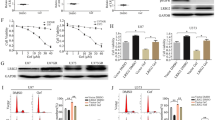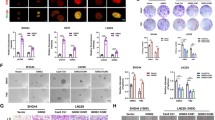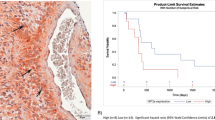Abstract
An essential mode of acquired resistance to radiotherapy (RT) appears to be promotion of tumor cell motility and invasiveness in various cancer types, including glioblastoma, a process resembling ‘evasive resistance’. Hence, a logical advancement of RT would be to identify suitable complementary treatment strategies, ideally targeting cell motility. Here we report that the combination of focal RT and mammalian target of rapamycin (mTOR) inhibition using clinically relevant concentrations of temsirolimus (CCI-779) prolongs survival in a syngeneic mouse glioma model through additive cytostatic effects. In vitro, the mTOR inhibitor CCI-779 exerted marked anti-invasive effects, irrespective of the phosphatase and tensin homolog deleted on chromosome 10 status and counteracted the proinvasive effect of sublethal irradiation. Mechanistically, we identified regulator of G-protein signaling 4 (RGS4) as a novel target of mTOR inhibition and a key driver of glioblastoma invasiveness, sensitive to the anti-invasive properties of CCI-779. Notably, suppression of RGS4-dependent glioma cell invasion was signaled through both mTOR complexes, mTORC1 and mTORC2, in a concentration-dependent manner, indicating that high doses of CCI-779 may overcome tumor-cell resistance associated with the sole inhibition of mTORC1. We conclude that combined RT and mTOR inhibition is a promising therapeutic option that warrants further clinical investigation in upfront glioblastoma therapy.
This is a preview of subscription content, access via your institution
Access options
Subscribe to this journal
Receive 50 print issues and online access
$259.00 per year
only $5.18 per issue
Buy this article
- Purchase on Springer Link
- Instant access to full article PDF
Prices may be subject to local taxes which are calculated during checkout





Similar content being viewed by others
Accession codes
References
Tabatabai G, Frank B, Mohle R, Weller M, Wick W . Irradiation and hypoxia promote homing of haematopoietic progenitor cells towards gliomas by TGF-beta-dependent HIF-1alpha-mediated induction of CXCL12. Brain 2006; 129: 2426–2435.
Wild-Bode C, Weller M, Rimner A, Dichgans J, Wick W . Sublethal irradiation promotes migration and invasiveness of glioma cells: implications for radiotherapy of human glioblastoma. Cancer Res 2001; 61: 2744–2750.
Minniti G, Amelio D, Amichetti M, Salvati M, Muni R, Bozzao A et al. Patterns of failure and comparison of different target volume delineations in patients with glioblastoma treated with conformal radiotherapy plus concomitant and adjuvant temozolomide. Radiother Oncol 2010; 97: 377–381.
Paez-Ribes M, Allen E, Hudock J, Takeda T, Okuyama H, Vinals F et al. Antiangiogenic therapy elicits malignant progression of tumors to increased local invasion and distant metastasis. Cancer Cell 2009; 15: 220–231.
Guertin DA, Sabatini DM . Defining the role of mTOR in cancer. Cancer Cell 2007; 12: 9–22.
Sarbassov DD, Guertin DA, Ali SM, Sabatini DM . Phosphorylation and regulation of Akt/PKB by the rictor-mTOR complex. Science 2005; 307: 1098–1101.
Jacinto E, Loewith R, Schmidt A, Lin S, Ruegg MA, Hall A et al. Mammalian TOR complex 2 controls the actin cytoskeleton and is rapamycin insensitive. Nat Cell Biol 2004; 6: 1122–1128.
Cancer Genome Atlas Research Network. Comprehensive genomic characterization defines human glioblastoma genes and core pathways Nature 2008; 455: 1061–1068.
Neshat MS, Mellinghoff IK, Tran C, Stiles B, Thomas G, Petersen R et al. Enhanced sensitivity of PTEN-deficient tumors to inhibition of FRAP/mTOR. Proc Natl Acad Sci USA 2001; 98: 10314–10319.
Podsypanina K, Lee RT, Politis C, Hennessy I, Crane A, Puc J et al. An inhibitor of mTOR reduces neoplasia and normalizes p70/S6 kinase activity in Pten+/- mice. Proc Natl Acad Sci USA 2001; 98: 10320–10325.
Chakravarti A, Zhai G, Suzuki Y, Sarkesh S, Black PM, Muzikansky A et al. The prognostic significance of phosphatidylinositol 3-kinase pathway activation in human gliomas. J Clin Oncol 2004; 22: 1926–1933.
Faivre S, Kroemer G, Raymond E . Current development of mTOR inhibitors as anticancer agents. Nat Rev Drug Discov 2006; 5: 671–688.
Doherty L, Gigas DC, Kesari S, Drappatz J, Kim R, Zimmerman J et al. Pilot study of the combination of EGFR and mTOR inhibitors in recurrent malignant gliomas. Neurology 2006; 67: 156–158.
Galanis E, Buckner JC, Maurer MJ, Kreisberg JI, Ballman K, Boni J et al. Phase II trial of temsirolimus (CCI-779) in recurrent glioblastoma multiforme: a North Central Cancer Treatment Group Study. J Clin Oncol 2005; 23: 5294–5304.
Reardon DA, Desjardins A, Vredenburgh JJ, Gururangan S, Friedman AH, Herndon JE et al. Phase 2 trial of erlotinib plus sirolimus in adults with recurrent glioblastoma. J Neurooncol 2010; 96: 219–230.
Stupp R, Hegi ME, Mason WP, van den Bent MJ, Taphoorn MJ, Janzer RC et al. Effects of radiotherapy with concomitant and adjuvant temozolomide versus radiotherapy alone on survival in glioblastoma in a randomised phase III study: 5-year analysis of the EORTC-NCIC trial. Lancet Oncol 2009; 10: 459–466.
Motzer RJ, Hudes GR, Curti BD, McDermott DF, Escudier BJ, Negrier S et al. Phase I/II trial of temsirolimus combined with interferon alfa for advanced renal cell carcinoma. J Clin Oncol 2007; 25: 3958–3964.
Hess G, Herbrecht R, Romaguera J, Verhoef G, Crump M, Gisselbrecht C et al. Phase III study to evaluate temsirolimus compared with investigator's choice therapy for the treatment of relapsed or refractory mantle cell lymphoma. J Clin Oncol 2009; 27: 3822–3829.
Dudkin L, Dilling MB, Cheshire PJ, Harwood FC, Hollingshead M, Arbuck SG et al. Biochemical correlates of mTOR inhibition by the rapamycin ester CCI-779 and tumor growth inhibition. Clin Cancer Res 2001; 7: 1758–1764.
Geoerger B, Kerr K, Tang CB, Fung KM, Powell B, Sutton LN et al. Antitumor activity of the rapamycin analog CCI-779 in human primitive neuroectodermal tumor/medulloblastoma models as single agent and in combination chemotherapy. Cancer Res 2001; 61: 1527–1532.
Sampson JH, Ashley DM, Archer GE, Fuchs HE, Dranoff G, Hale LP et al. Characterization of a spontaneous murine astrocytoma and abrogation of its tumorigenicity by cytokine secretion. Neurosurgery 1997; 41: 1365–1372.
Park IH, Bachmann R, Shirazi H, Chen J . Regulation of ribosomal S6 kinase 2 by mammalian target of rapamycin. J Biol Chem 2002; 277: 31423–31429.
O'Reilly KE, Rojo F, She QB, Solit D, Mills GB, Smith D et al. mTOR inhibition induces upstream receptor tyrosine kinase signaling and activates Akt. Cancer Res 2006; 66: 1500–1508.
Copp J, Manning G, Hunter T . TORC-specific phosphorylation of mammalian target of rapamycin (mTOR): phospho-Ser2481 is a marker for intact mTOR signaling complex 2. Cancer Res 2009; 69: 1821–1827.
Garcia-Martinez JM, Alessi DR . mTOR complex 2 (mTORC2) controls hydrophobic motif phosphorylation and activation of serum- and glucocorticoid-induced protein kinase 1 (SGK1). Biochem J 2008; 416: 375–385.
Hu W, Li F, Mahavadi S, Murthy KS . Upregulation of RGS4 expression by IL-1beta in colonic smooth muscle is enhanced by ERK1/2 and p38 MAPK and inhibited by the PI3K/Akt/GSK3beta pathway. Am J Physiol Cell Physiol 2009; 296: C1310–1320.
Sarkaria JN, Galanis E, Wu W, Dietz AB, Kaufmann TJ, Gustafson MP et al. Combination of temsirolimus (CCI-779) with chemoradiation in newly diagnosed glioblastoma multiforme (GBM) (NCCTG trial N027D) is associated with increased infectious risks. Clin Cancer Res 2010; 16: 5573–5580.
Phillips HS, Kharbanda S, Chen R, Forrest WF, Soriano RH, Wu TD et al. Molecular subclasses of high-grade glioma predict prognosis, delineate a pattern of disease progression, and resemble stages in neurogenesis. Cancer Cell 2006; 9: 157–173.
Ronellenfitsch MW, Brucker DP, Burger MC, Wolking S, Tritschler F, Rieger J et al. Antagonism of the mammalian target of rapamycin selectively mediates metabolic effects of epidermal growth factor receptor inhibition and protects human malignant glioma cells from hypoxia-induced cell death. Brain 2009; 132: 1509–1522.
Bansal G, Druey KM, Xie Z . R4 RGS proteins: regulation of G-protein signaling and beyond. Pharmacol Ther 2007; 116: 473–495.
Hurst JH, Hooks SB . Regulator of G-protein signaling (RGS) proteins in cancer biology. Biochem Pharmacol 2009; 78: 1289–1297.
Cotton M, Claing A . G protein-coupled receptors stimulation and the control of cell migration. Cell Signal 2009; 21: 1045–1053.
De Vries L, Zheng B, Fischer T, Elenko E, Farquhar MG . The regulator of G protein signaling family. Annu Rev Pharmacol Toxicol 2000; 40: 235–271.
Xie Y, Wolff DW, Wei T, Wang B, Deng C, Kirui JK et al. Breast cancer migration and invasion depend on proteasome degradation of regulator of G-protein signaling 4. Cancer Res 2009; 69: 5743–5751.
Tatenhorst L, Senner V, Puttmann S, Paulus W . Regulators of G-protein signaling 3 and 4 (RGS3, RGS4) are associated with glioma cell motility. J Neuropathol Exp Neurol 2004; 63: 210–222.
Erdely HA, Lahti RA, Lopez MB, Myers CS, Roberts RC, Tamminga CA et al. Regional expression of RGS4 mRNA in human brain. Eur J Neurosci 2004; 19: 3125–3128.
Ding J, Guzman JN, Tkatch T, Chen S, Goldberg JA, Ebert PJ et al. RGS4-dependent attenuation of M4 autoreceptor function in striatal cholinergic interneurons following dopamine depletion. Nat Neurosci 2006; 9: 832–842.
Hooks SB, Martemyanov K, Zachariou V . A role of RGS proteins in drug addiction. Biochem Pharmacol 2008; 75: 76–84.
Levitt P, Ebert P, Mirnics K, Nimgaonkar VL, Lewis DA . Making the case for a candidate vulnerability gene in schizophrenia: Convergent evidence for regulator of G-protein signaling 4 (RGS4). Biol Psychiatry 2004; 60: 534–537.
Blazer LL, Roman DL, Chung A, Larsen MJ, Greedy BM, Husbands SM et al. Reversible, allosteric small-molecule inhibitors of regulator of G protein signaling proteins. Mol Pharmacol 2010; 78: 524–533.
Guertin DA, Sabatini DM . The pharmacology of mTOR inhibition. Science Signal 2009 2 pe24.
Pitter KL, Galban CJ, Galban S, Saeed-Tehrani O, Li F, Charles N et al. Perifosine and CCI 779 co-operate to induce cell death and decrease proliferation in PTEN-intact and PTEN-deficient PDGF-driven murine glioblastoma. PloS One 2011; 6: e14545.
Yang L, Clarke MJ, Carlson BL, Mladek AC, Schroeder MA, Decker P et al. PTEN loss does not predict for response to RAD001 (Everolimus) in a glioblastoma orthotopic xenograft test panel. Clin Cancer Res 2008; 14: 3993–4001.
Svendsen CN, ter Borg MG, Armstrong RJ, Rosser AE, Chandran S, Ostenfeld T et al. A new method for the rapid and long term growth of human neural precursor cells. J Neurosci Methods 1998; 85: 141–152.
Rieger J, Lemke D, Maurer G, Weiler M, Frank B, Tabatabai G et al. Enzastaurin-induced apoptosis in glioma cells is caspase-dependent and inhibited by BCL-XL . J Neurochem 2008; 106: 2436–2448.
Smyth GK . Linear models and empirical bayes methods for assessing differential expression in microarray experiments. Stat Appl Genet Mol Biol 2004; 3: Article3.
Edgar R, Domrachev M, Lash AE . Gene Expression Omnibus: NCBI gene expression and hybridization array data repository. Nucleic Acids Res 2002; 30: 207–210.
Opitz CA, Litzenburger UM, Lutz C, Lanz TV, Tritschler I, Koppel A et al. Toll-like receptor engagement enhances the immunosuppressive properties of human bone marrow-derived mesenchymal stem cells by inducing indoleamine-2,3-dioxygenase-1 via interferon-beta and protein kinase R. Stem Cells 2009; 27: 909–919.
Weiler M, Bahr O, Hohlweg U, Naumann U, Rieger J, Huang H et al. BCL-xL: time-dependent dissociation between modulation of apoptosis and invasiveness in human malignant glioma cells. Cell Death Differ 2006; 13: 1156–1169.
Wen PY, Macdonald DR, Reardon DA, Cloughesy TF, Sorensen AG, Galanis E et al. Updated response assessment criteria for high-grade gliomas: response assessment in neuro-oncology working group. J Clin Oncol 2010; 28: 1963–1972.
Acknowledgements
We thank P Rübmann, A-C Klein and N Sims for excellent technical assistance. We also thank the Microscopy Core Facility of the DKFZ and the Nikon Imaging Center at the University of Heidelberg, Heidelberg, Germany. We are grateful to T Wieland, University of Heidelberg, Mannheim, Germany, for providing the pCR3.0-RGS4 expression vector. This work was supported by the Brain Tumor Network (BTNplus), Subproject 10 01GS0883 (WW) and Subproject 4 (JG, LMD) of the National Genome Research Network (NGFNplus) by the Federal Ministry of Education and Research (BMBF), and the Charitable Hertie Foundation. BB is a fellow in the Postdoc Program of the Medical Faculty of the University of Heidelberg.
Author information
Authors and Affiliations
Corresponding author
Ethics declarations
Competing interests
MK is an employee of Pfizer, the company manufacturing CCI-779. All other authors declare no conflict of interest.
Additional information
Supplementary Information accompanies the paper on the Oncogene website
Supplementary information
Rights and permissions
About this article
Cite this article
Weiler, M., Pfenning, PN., Thiepold, AL. et al. Suppression of proinvasive RGS4 by mTOR inhibition optimizes glioma treatment. Oncogene 32, 1099–1109 (2013). https://doi.org/10.1038/onc.2012.137
Received:
Revised:
Accepted:
Published:
Issue Date:
DOI: https://doi.org/10.1038/onc.2012.137
Keywords
This article is cited by
-
Function and regulation of RGS family members in solid tumours: a comprehensive review
Cell Communication and Signaling (2023)
-
Rgs4 is a regulator of mTOR activity required for motoneuron axon outgrowth and neuronal development in zebrafish
Scientific Reports (2021)
-
The Route to ‘Chemobrain’ - Computational probing of neuronal LTP pathway
Scientific Reports (2019)
-
Distinctive epigenomes characterize glioma stem cells and their response to differentiation cues
Genome Biology (2018)



